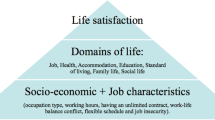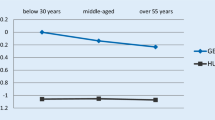Abstract
This paper analyzes the levels of job satisfaction reported by older workers (aged 50–64) with and without disability by using an aggregating approach in which job satisfaction is seen as a combination of various job satisfaction domains (physical effort, time pressure, level of freedom, capability to develop new skills, support in the workplace, recognition of the work, salary, promotion prospect and job security). Using the Survey of Health, Ageing and Retirement in Europe, we estimate a two-layer model based on the interrelation between the different domains of job satisfaction and wherein the individual’s overall job satisfaction depends on each of these domains. The results show that the levels of satisfaction with the recognition of the work, support in difficult situations and physical effort have a significant effect on the overall job satisfaction reported by limited disabled workers. For this group, the trade-offs between the domains recognition with work and support and satisfaction with salary are especially high. These findings can help organizations, managers and policy makers to design or modify current jobs to make them more attractive in terms of satisfaction for limited disabled older workers.


Similar content being viewed by others
Notes
Alternatively, we have tried to estimate the Eqs. (1) and (2) distinguishing three possible European geographical areas: Scandinavian countries, Central European Countries and Mediterranean countries. However, the sample sizes are still very low in the Central Europe countries for the non-limited and limited disabled samples (125 and 93 observations, respectively) which have made such an analysis not possible.
For example, see Oliver (1996) for more information on the social model of disability.
In our case, we have nine domains of job satisfaction and four possible levels of satisfaction (i.e. strongly agree, agree, disagree or strongly disagree), and thus the number of dummy variables that should be included in the Eq. (1) is 27 (= 9*(4 − 1)).
For example, see van Praag and Ferrer-i-Carbonell (2004) for more examples of computation of trade-offs between different domains of job satisfaction.
References
Akerlof, G., Rose, A., & Yellen, J. (1988). Job switching and job satisfaction in the US labour market. Brooking Papers on Economic Activity, 2, 495–582.
Baldwin, M., & Johnson, W. (2006). A critical review of studies of discrimination against workers with disabilities. In W. Rodgers III (Ed.), Handbook on the economics of discrimination. Northampton, MA: Edgar Elgar Publishing.
Baldwin, M., & Schumacher, E. (2002). A note on job mobility among workers with disabilities. Industrial Relations, 41(3), 430–441.
Bender, K., Donohue, S., & Heywood, J. (2006). Job Satisfaction and gender Segregation. Oxford Economic Papers, 57, 479–496.
Benz, M., & Frey, B. (2008). Being independent is a great thing: subjective evaluations of self-employment and hierarchy. Economica, 75, 362–383.
Blanchflower, D., & Oswald, A. (2007). Is well-being U-shaped over the life cycle? NBER working paper no. 12935.
Blanck, P. (2005). Americans with disabilities and their civil rights: past, present and future. University of Pitsburg Law Review, 66, 687–719.
Blanck, P., Hill, E., Siegal, C., & Waterstone, M. (2005). Disability civil rights law and policy. St Paul, MN: Thomson/West.
Bound, J. (1991). Self-reported versus objective measures of health in retirement models. Journal of Human Resources, 26(1), 106–138.
Boyle, M. (1997). Social barriers to successful reentry into mainstream organizational culture: Perceptions of people with disabilities. Human Resources Development Quarterly, 8, 259–268.
Burchardt, T. (2000). The dynamics of being disabled. Journal of Social Policy, 29(4), 645–668.
Burke, R. (1999). Disability & women’s work experiences: An explanatory study. International Journal of Sociology and Social Policy, 19(2), 21–33.
Chirikos, T., & Nestel, G. (1984). Economic determinants and consequences of self-reported work disability. Journal of Health Economics, 3(2), 117–136.
Clark, A. (1997). Job satisfaction and gender: Why are women so happy at work? Labour Economics, 4(4), 341–372.
Clark, A. (1998). Measures of job satisfaction—what makes a good job? Evidence from OECD countries. Labour market and social policy—occasional paper no. 34, OECD, Paris.
DeLeire, T. (2001). Changes in wage discrimination against people with disabilities: 1984–93. Journal of Human Resources, 36, 144–158.
Eichar, D., Norland, S., Brady, M., & Fortinsky, R. (1991). The job satisfaction of older workers. Journal of Organizational Behavior, 12, 609–620.
European Commission. (2010). Employment in Europe. Directorate-general for employment, social affairs and inclusion. Brussels: Employment Analysis Unit.
European Social Network. (2008). Services for older people in Europe. European Commission. Available at http://www.esn-eu-org.
Ferraro, K., Farmer, M., & Wybraniec, J. (1997). Health trajectories: Long-term dynamics among black and white adults. Journal of Health and Social Behavior, 38(March), 38–54.
Ferrer-i-Carbonell, A., & Frijters, P. (2004). How important is methodology for the estimates of the determinants of happiness? The Economic Journal, 114, 641–659.
Freeman, R. (1978). Job satisfaction as an economic variable. American Economic Review, 68, 135–141.
Frey, B., Benz, M., & Stutzer, A. (2004). Introducing procedural utility: Not only what, but also how matters. Journal of Institutional and Theoretical Economics, 160(3), 377–401.
Friedman, M. (1957). A theory of the consumption function. Princeton: Princeton University Press.
Gannon, B. (2005). A dynamic analysis of disability and labour force participation in Ireland 1995–2000. Health Economics, 4(9), 925–938.
Gannon, B., & Munley, M. (2009). Age and disability: Explaining the wage differential. Social Science and Medicine, 69, 47–55.
Greene, W. (2000). Econometric analysis. Upper Saddle River, NJ: Prentice Hall International.
Greene, W. (2005). Censored data and truncated distributions. In T. Mills, & K. Patterson (Eds.), The handbook of econometrics (Vol. 1). London: Palgrave (forthcoming).
Groot, W. (1999). Job satisfaction of older workers. International Journal of Manpower, 30(6), 343–360.
Jones, M., Latreille, P., & Sloane, P. (2006). Disability, gender and the British labour market. Oxford Economics Papers, 58, 407–449.
Jung, K., Moon, M. J., & Deuk, S. (2007). Do age, gender and sector affect job satisfaction. Review of Public Personnel Administration, 27(2), 125–146.
Kalleberg, A. (1977). Work values and job rewards: A theory of job satisfaction. American Sociological Review, 42, 124–143.
Karasek, R. (1979). Job demand, job decision latitude, and mental strain: Implications for job redesign. Administrative Science Quarterly, 24(2), 285–308.
Kidd, M., Sloane, P., & Ferko, I. (2000). Disability and the labour market: An analysis of British males. Journal of Health Economics, 19(6), 961–981.
Kreider, B. (1999). Latent work disability and reporting bias. Journal of Human Resources, 34(4), 734–769.
Lund, T., Labriola, M., Christensen, K., Bültmann, U., & Villadsen, E. (2006). Physical work environment risk factors for long term sickness absence: Prospective findings among a cohort of 5357 employees in Denmark. British Medical Journal, 25(332), 449–452.
Malo, M. A., & Pagán, R. (2011). Wage differentials and disability: Discrimination and/or lower productivity? International Labour Review (forthcoming).
Marti, W., & Blanck, P. (2000). Attitudes, behavior and the ADA. In P. Blanck (Ed.), Employment, disability, and the Americans with disabilities ACT: Issues in law, public policy, and research. Evanston, IL: Northwestern University Press.
McClelland, D. (1961). The achieving society. Princeton, NJ: Van Nostrand.
Mundlak, Y. (1978). On the pooling of time series and cross section data. Econometrica, 46, 69–85.
Ng, Y. (1997). A case of happiness, cardinalism, and interpersonal comparability. The Economic Journal, 107(445), 1848–1858.
OECD. (2003). Transforming disability into ability: Policies to promote work and income security for disabled people. Paris: Directorate for Employment, Labour and Social Affaire.
Oliver, M. (1996). Understanding disability: From theory to practice. London: Palgrave Macmillan.
Pagán, R. (2011). Ageing and disability: Job satisfaction differentials across Europe. Social Science and Medicine, 72(2), 206–215.
Pagan, R., & Malo, M. A. (2009). Job satisfaction and disability: Lower expectations about jobs or a matter of health? Spanish Economic Review, 11, 51–74.
Renaud, S. (2002). Rethinking the union membership/job satisfaction relationship: Some empirical evidence in Canada. International Journal of Manpower, 23(2), 137–150.
Ryan, R., & Deci, E. (2000). The ‘what’ and ‘why’ of goal pursuits: Human needs and the self-determination of behavior. Psychological Inquiry, 11, 227–268.
Schur, L., Kruse, D., Blasi, J., & Blanck, P. (2009). Is disability disabling in all workplaces? Workplace disparities and corporate culture. Industrial Relations, 48(3), 381–410.
Schwartz, N. (1995). What respondents learn from questionnaires: The survey interview and the logic of conversation. International Statistical Review, 63, 153–177.
Shelton, C., & Lipton, R. (1983). An alternative employment model. Mental Retardation, 33(2), 12–16.
Sousa-Poza, A., & Sousa-Poza, A. (2000). Well-being at work: a cross-national analysis of the levels and determinants of job satisfaction. Journal of Socio-Economics, 29(6), 517–538.
Terza, J. (1987). Estimating linear models with ordinal qualitative regressors. Journal of Econometrics, 34, 275–291.
UppalS. (2005). Disability, workplace characteristics and job satisfaction. International Journal of Manpower, 26(4), 336–349.
van Praag, B. (1991). Ordinal and cardinal utility: An integration of the two dimensions of the welfare concept. Journal of Econometrics, 50, 69–89.
van Praag, B., & Ferrer-i-Carbonell, A. (2004). Quantified happiness: A satisfaction calculus approach. UK: Oxford University Press, Oxford.
van Praag, B., & Ferrer-i-Carbonell, A. (2006). An almost integration-free approach to ordered response models. Tinbergen Institute discussion paper no. 47/3.
van Praag, B., Frijters, P., & Ferrer-i-Carbonell, A. (2003). The anatomy of subjective well-being. Journal of Economic Behavior & Organization, 51, 29–49.
Vandergoot, D. (1991). Using natural worksite supports to enhance supported employment outcomes. Albertson, NY: Research and Training Institute, National Center for Disability Services.
Verbeek, M., & Nijman, T. (1992). Testing for selectivity bias in panel data models. International Economic Review, 33(3), 681–703.
Verbrugge, L., Reoma, J., & Gruber-Baldini, A. (1994). Short-term dynamics of disability and well-being. Journal of Health and Social Behavior, 35(2), 97–117.
von Thiele, U., Lindfors, P., & Lundberg, U. (2006). Evaluating different measures of sickness absence with respect to work characteristics. Scandinavian Journal of Public Health, 34(3), 247–253.
Yelin, E., & Trupin, L. (2003, May). Disability and the characteristics of employment. Monthly Labor Review, 20–31.
Acknowledgments
The author thanks two anonymous reviewers and the editor for useful comments and suggestions. This paper uses data from the SHARE, which has been primarily funded by the European Commission through the 5th framework programme (project QLK6-CT-2001-00360 in the thematic programme Quality of Life), through the 6th framework programme (projects SHARE-I3, RII-CT-2006-062193, COMPARE, CIT5-CT-2005-028857, and SHARELIFE, CIT4-CT-2006-028812) and through the 7th framework programme (SHARE-PREP, 211909 and SHARE-LEAP, 227822). The usual disclaimer applies.
Author information
Authors and Affiliations
Corresponding author
Rights and permissions
About this article
Cite this article
Pagán, R. Job Satisfaction and Domains of Job Satisfaction for Older Workers with Disabilities in Europe. J Happiness Stud 14, 861–891 (2013). https://doi.org/10.1007/s10902-012-9359-x
Published:
Issue Date:
DOI: https://doi.org/10.1007/s10902-012-9359-x




